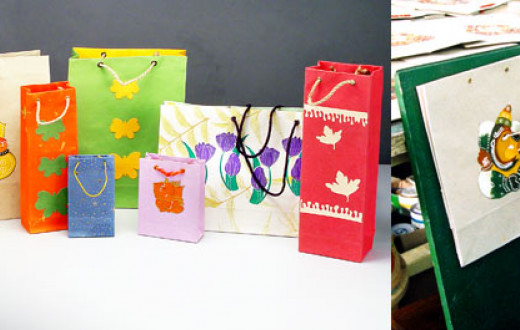‘Violence ends where love begins.’ - Gurudev Sri Sri Ravi Shankar
The village of Senari in Bihar, is infamous for frequent massacres by the Naxalites (Ranveer Sena, Communist Party of India (ML), People’s War Group, and Mala, are some of the Naxal outfits that are active in Senari), leaving the villagers in a state of terror. Mrs. Indu Sinha, a faculty of The Art of Living, mustered the strength to venture into this area, to sow the seeds of nonviolence.
In August 2000, Mrs. Indu Sinha came across a news report in one of Bihar’s local newspapers, about a massacre that had taken place in the village of Senari; nearly 67 people were beheaded by a Naxal group. It was a common feature in the villages of Bihar to hear such shocking news, and most people had accepted this as a normal way of life. From childhood, people had been hearing and reading of violence and killings being carried out. Mrs. Sinha was deeply moved when she learned about the massacre in the village and decided that she had to do something about it.
How it began
In a meeting with Gurudev Sri Sri Ravi Shankar in Delhi, she expressed her feelings regarding the depleting human values in these villages of Bihar. Gurudev encouraged her to start a school in the village of Senari. She set off for the village, with a mission to change the conditions there. Access to the notorious village was not easy.
She reached the village after three hours of battling through watersheds. As expected, the massacre had drawn a lot of media attention, and other social organizations had attempted to send in their representatives to improve the situation, but no one was successful. The first and foremost task before Mrs. Sinha was to convince the parents in the village to send their children to attend school.
On the flipside, this was the last thing in the world that those parents wanted to do. Mrs. Sinha started taking personal responsibility for each child, and the school gradually materialized in the violent village of Senari. There were not many men to be seen in the village. This made her task even more difficult. Quite a few of the menfolk in the village had been killed by the terrorist groups, and the ones that had escaped were tucked away in prison cells. Convincing the women left at home, was rather difficult. However, they gradually realized the genuineness and love behind The Art of Living, and its school project, and began supporting the cause.
The next step
Once the school was successfully started, Mrs. Sinha returned to Patna with the idea of starting the Prison Program.’ Something definitely had to be done for the inmates. In fact, she thought that the jails would be the only place where she would get the opportunity to meet the members of different Naxal groups. She felt that she could bring about a transformation while they were still under the watchful eye of the law. It would be a new beginning for them and their families. This inspired her to organize a Prison Program for the inmates of Beur Jail.
The District Magistrate had certain reservations about allowing a woman into the jail premises with hardened criminals. Despite the apparent problems, Mrs. Sinha started the Prison Program with the jail inmates, under tight security. The Prison Program’ was one of its kind; a progressive, practical and result-oriented program, providing compassionate, innovative and effective solutions for breaking the cycles of violence, and tackling the escalating global crime rates. This program also gave the prisoners the opportunity to rehabilitate, and integrate themselves into the society at large. The benefits are primarily possible due to the Sudarshan Kriya, a breathing technique devised by Gurudev. Sudarshan Kriya completely roots out stress, which is the primary cause of crime.
The mantra of love & forget
The prisoners in Beur Jail were hard-core criminals, who were imprisoned for more than 200 crimes. Mrs. Sinha told the jail authorities that such tight security was not really necessary. In fact, she told the prisoners that they were her security personnel. The basic nature of all human beings is not of violence, but of love. What really changes a person is the environment, and what all is going through in their lives.
Gurudev says, “There is a victim hidden behind every culprit. With love, compassion, understanding, and patience, there is no way that the change will not happen.” With extreme sensitivity and gentleness, Mrs. Sinha explained to the inmates that hatred and violence are futile, and a transformation was possible, even inside the jail.
“What really changes a person is the environment and what they are going through in their life. I explained to the inmates that hatred and violence is futile and the most important thing is to change the present situation and usher in peacefulness.”
The most important thing that matters is to change the present situation, and in the place of violence usher in the feeling of love and peace. Love one another and forget whatever happened in the past.
Such a change
The transformation began, evident even in four dreaded inmates who were constantly involved in internal jail violence and a huge threat to the jail staff itself. They soon began referring to Indu as Didi (sister).
The inmates were full of gratitude. The jail superintendent, Mr. Surendra Kumar Gupta, observed the overall change in the behavior and in the attitude of the inmates. He was surprised to see a visible change in four of the most dreaded prisoners. Reformist cop Ms. Kiran Bedi had once said, “The inmates behind bars go through stress because of being away from their families, and the worry of their family’s well being always haunts them. Even the police, dealing with the offenders undergo severe stress. The Art of Living program has special relevance for these two sections.” The same men, who had evoked terror in the hearts of people, and were a source of constant worry for the jail security staff, became harmless and obedient. Their menacing looks were replaced with benign expressions.
Rama Chandra Singh, a fifty-five-year-old man, had been in prison for four years. He was considered to be a very dangerous man with a penchant for engineering discord. He has now vowed not to indulge in any criminal activity, ever. He said, “Pehle kuch bhi karta thaa galat hi karta thaa” (Earlier, whatever I did was always wrong).
Hari Badan Singh, another dreaded criminal, is now able to keep his anger under control and enjoys complete peace of mind. He suddenly developed feelings of love and affection for everyone. Largely, participation in the program brought about a sense of well-being, and a lot of the participants got cured of their physical ailments too.
The numbers increase
The program came to an end on January 13, but the prisoners would not let Indu leave, stating that as per Indian tradition the daughter of the house does not leave her home on that particular calendar date. A deeply moved Indu acquiesced to their wish and left the next day, on the auspicious occasion of Sankranti.
A sea of once hardened criminals with menacing looks were now softened and healed with eyes filled with tears of love and gratitude as they escorted Indu to the prison gates. Observing this behavioral and attitudinal change was the head warden, Mr. Ganesh Prashad, who turned to the Jail Superintendent, Mr. Surendra Kumar Gupta, standing by his side, and said, “Yeh sab toh sadhu sant ban gayen hain! (All of them have now become saints!)”
Since then, similar programs have been conducted in all the Central and District Jails of Bihar, and the results have been revolutionary. In Patna, Aara, Gaya, and Muzzafarpur over 4,000 prisoners have experienced the Prison Program with more than 2,500 inmates in Beur Jail alone. It wouldn’t be wrong to say, “Once a jail, now an ashram.”
Media Coverage:
Times of India, June 15, 2009:
Times of India, October 10, 2001
India Today, March 3, 2009
Writer: Eben Felix













